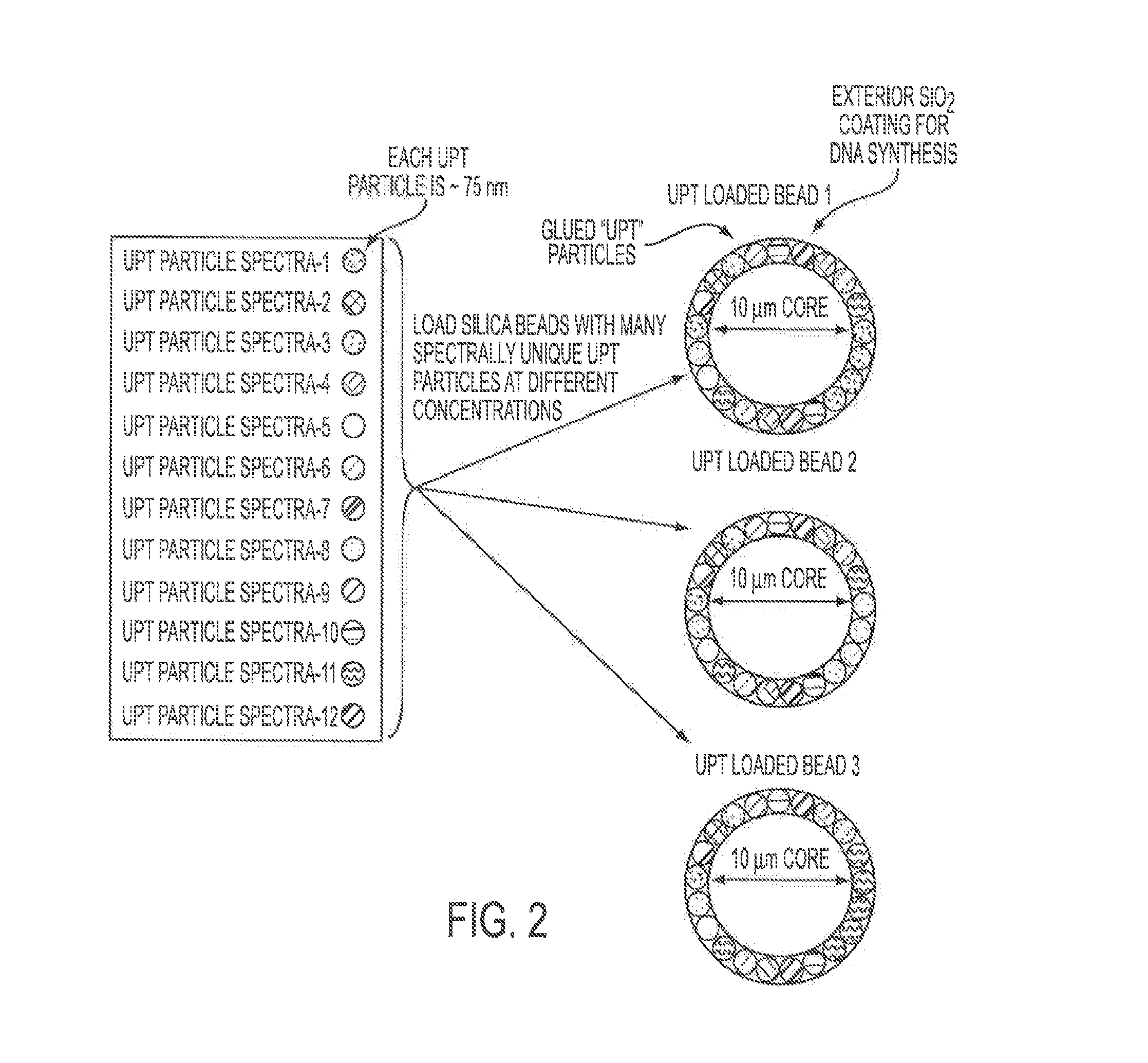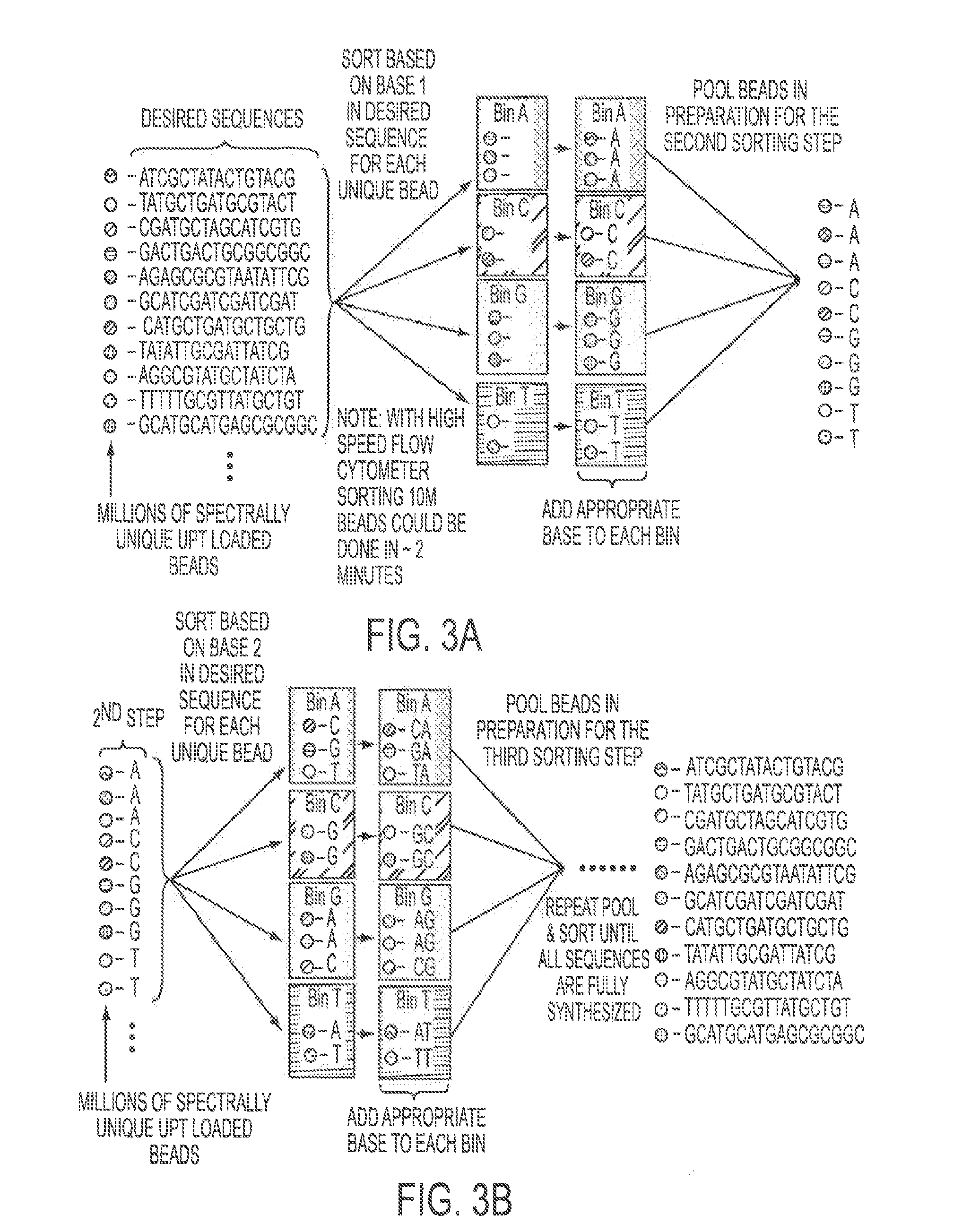Chemical synthesis using up-converting phosphor technology and high speed flow cytometry
a phosphor and flow cytometry technology, applied in the field of chemical synthesis using up-converting phosphor technology and high-speed flow cytometry, can solve the problems of only being conducted in specialized laboratories, the field has the potential to radically change the way biological systems are engineered, and the cost of dna sequencing has dropped dramatically. , to achieve the effect of low cost, minimal background interference, and high efficiency
- Summary
- Abstract
- Description
- Claims
- Application Information
AI Technical Summary
Benefits of technology
Problems solved by technology
Method used
Image
Examples
example 1
[0134]In the following example, approximately 6 to 6.5 micron diameter silica particles were coated with YYbEr particles.
[0135]One gram of silica particles was added to a bottle containing 50 g of anhydrous ethanol. The mixture was sonicated for 0.5 hr in a Branson® (Danbury, Conn.) model 1210 ultrasonic bath, and then magnetically stirred at 500 rpm for 16 hr to disperse the silica particles (the silica dispersion)
[0136]In a separate bottle, 1.0 g Disperbky®-190 (BYK Additives & Instruments, the Altana Group, Wesel, Germany) was dissolved in 50 g anhydrous ethanol, and then 0.1 g of YYbEr particles was added to the solution. The mixture was sonicated for 0.5 hr, and magnetically stirred at 500 rpm for 16 hr to disperse the YYbEr particles (the up-converting phosphor dispersion). The up-converting phosphor dispersion was added, dropwise with a pipette, to the silica dispersion, and the mixture was sonicated for 0.5 hr, and then magnetically stirred for three days to make a silica / up...
example 2
[0137]In the following example, approximately 6 to 6.5 micron diameter silica particles were coated with coated with three different up-converting phosphor particles.
[0138]One gram of silica particles were added to a bottle containing 50 g of anhydrous ethanol. The mixture was sonicated for 0.5 hr in a Branson® (Danbury, Conn.) model 1210 ultrasonic bath, and then magnetically stirred at 500 rpm for 16 hr to disperse the silica particles (the silica dispersion)
[0139]In three separate bottles, 0.5 g Disperbky®-190 (BYK Additives & Instruments, the Altana Group, Wesel, Germany) was dissolved in 25 g anhydrous ethanol, and then 30 mg each of three different species of up-converting phosphor particles were added to the three solutions. The up-converting phosphor particles emitted green, blue, and yellow light respectively. The dispersions were sonicated for 0.5 hr, and magnetically stirred at 500 rpm for 16 hr to disperse the up-converting phosphor particles (the up-converting phosphor ...
PUM
| Property | Measurement | Unit |
|---|---|---|
| diameter | aaaaa | aaaaa |
| diameter | aaaaa | aaaaa |
| diameter | aaaaa | aaaaa |
Abstract
Description
Claims
Application Information
 Login to View More
Login to View More - R&D
- Intellectual Property
- Life Sciences
- Materials
- Tech Scout
- Unparalleled Data Quality
- Higher Quality Content
- 60% Fewer Hallucinations
Browse by: Latest US Patents, China's latest patents, Technical Efficacy Thesaurus, Application Domain, Technology Topic, Popular Technical Reports.
© 2025 PatSnap. All rights reserved.Legal|Privacy policy|Modern Slavery Act Transparency Statement|Sitemap|About US| Contact US: help@patsnap.com



